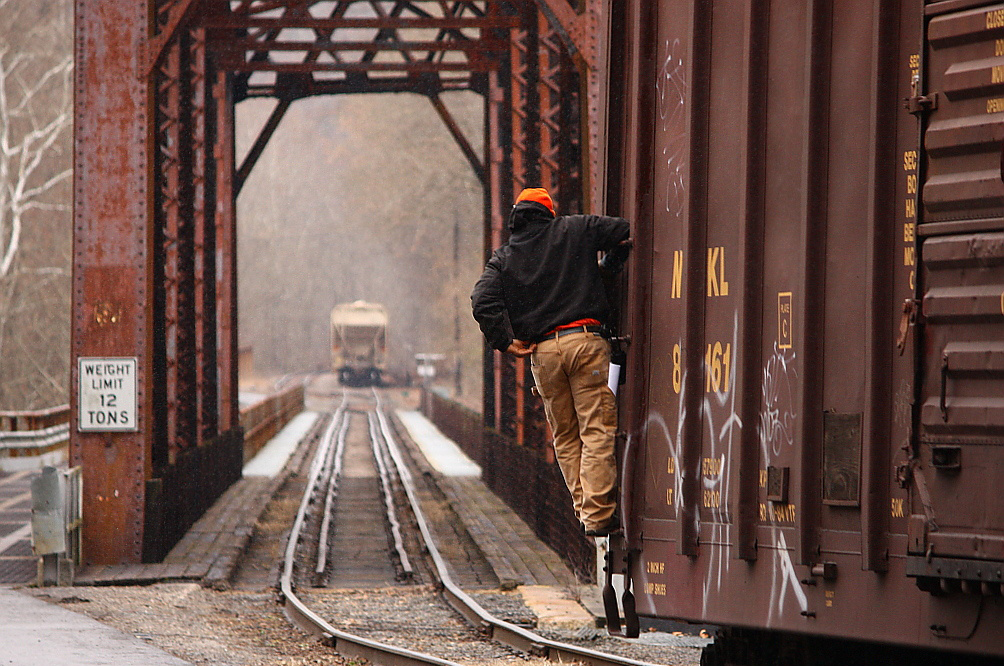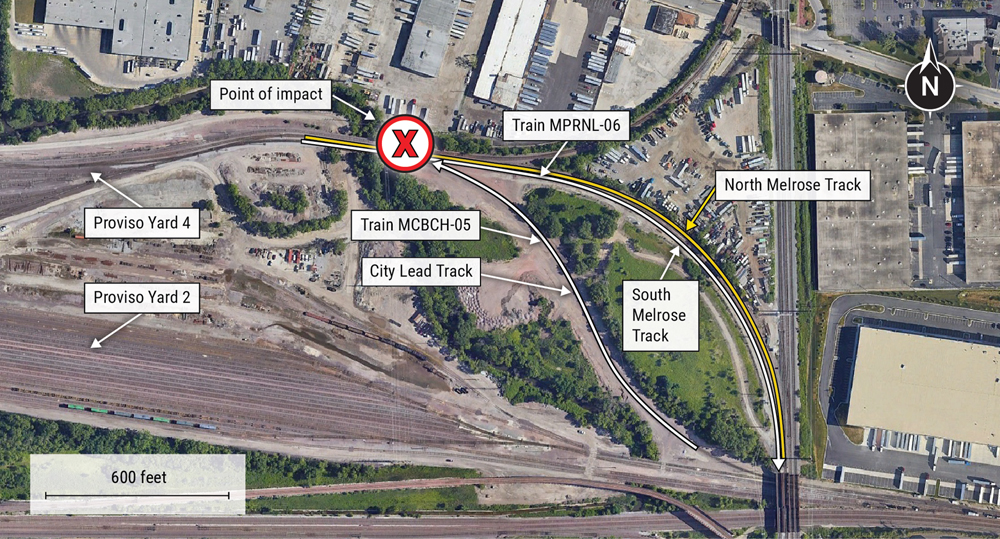The bulletin, which took effect at 12:01 a.m. on Tuesday, March 14, applies to trained employees who have been qualified by a supervisor regarding the rule change and have demonstrated proficiency in the task, the bulletin reads.
The new rule change includes a checklist of items that must be performed before an employee can mount or dismount moving equipment, including scanning the area for obstructing objects, maintaining three points of contact, staying clear of adjacent tracks, and first applying a boot to the bottom step or ladder rung to verify proper footing before continuing with the mount or dismount.
According to the bulletin, the new rules supersede existing CSX “safe way” rules and will be a part of broader revisions that will be implemented in the new CSX employee operating manual that will take effect on April 1, 2017.
Sources familiar with the rule tell News Wire this is one of the first rulebook modifications implemented under E. Hunter Harrison’s leadership at CSX.
Trains News Wire has reached out to CSX for additional comment.















Wow, really? Of all the EHH tactics to not agree with, one that saves time and fuel is the one you complain about? Mounting and dismounting moving equipment is a skill as old as railroading itself. It should have never been made against the rules, and it’s nice to see it being brought back.
Do you really think as many companies that have brought it back would have kept it around had they witnessed an immediate increase in frequency and severity of on-duty injuries attributed to the practice? Uh, no.
Did it many times as s Yard Clerk prior to computers. Ride up and walk back doing paper work, etc.
Is E Hurricane going to show us all how its done?
nothing like having o stop 10,000 tons 8500 feet long to let the Conductor get off then be told “go ahead 10 cars to the cut.”
I hated this rule when CSX started this and most trainmen did too.
Seems we started this when Jerry Davis came over from the UP and it had been put in effect.
Does anyone have a copy of the bulletin?
As long as Hunter is trading safety for productivity lets change rule G to allow amphetamines. You will see some switching mofos.
Great change, it makes for better train handling, especially on grades where slack action can create rough train handling. It is much more efficient saving time, smooth operation of the train and safe. As an Engineer for 39 years on the B&A Boston Line, I had many Conductors and Brakeman who could get on and off at higher speeds and never got hurt. The people that wrote these rules never ran a train, had no idea about the handling of trains, and most of the time rules were made because of law suits, if one incident occurred. When I started in 1969 you couldn’t go fast enough fro the old timers. This is the first good thing I see coming out of Hunter Harrison as CEO. The railroads have always made corrections after the fact and always went overboard with the correction. You need a highly trained crew, that can do the job, and if they can’t perform the task they shouldn’t be Conductor’s or brakemen.
Watching old videos of switching crews is like watching graceful dancing.
You know, dancing isn’t “safe” either. (Injuries do happen.) But it is worth it.
Anyone seen the movie Unstoppable?
26 years never fell getting on and off equipment. safety first and you won’t get hurt.
Now can we get back to kicking cars and dropping cars again. Common sense and fast switching.
I remember watching crews switching cars in the 50’s jumping on and off moving cars. On the PRR’s Elmira branch they had to have a “swing brakeman” on the portion in N.Y. state. He got on or at the first block station in PA. According to the employee timetable the trains were to reduce speed to 10 mph for the purpose. That was in the steam era, no speedometers on the locomotives or radios.
As a young brakeman (not at CSX), this is among the skills for which I received close instruction. My superiors took it very seriously, correcting my technique and observing me for some time before allowing me to operate on my own. After having everything explained, I never felt in danger, it just seemed like a regular part of railroading.
I didn’t know CSX didn’t allow this – is that common at class 1s? It seems like stopping every time would waste an incredible amount of time, especially for efficiency obsessed mega railroads.
One thing that doesn’t add up: applying a boot to the bottom step *before* mounting to “verify” proper footing… so you’re supposed to run along the train kicking at bottom steps to check that it’s secure? On the mounting side, I remember a proper grab being much more important, along with using the correct foot relative to the direction of movement.
In the Summer of 1964 when I was a child, the Houston and San Antonio sections of”The Texas Eagle” were being combined at Palestine, Texas. After most of the switching was completed, my mother and I were allowed to board our assigned Pullman from San Antonio as the Houston section was without one on this particular day..
Mother boarded first and then as I boarded, the train started to move with my left foot still on the ground. That was a startling experience. The engineer of the switcher that was still coupled to our Pullman could have been reprimanded if not fired!
I remember rolling crew changes back in the 1980s. Didn’t realize they had stopped that.
Interesting. I remember when this prohibition came to Conrail being told by a trainmaster that it would slow yard switching activity by 40%.
A common sense rule.
Started work on the L&N in 1964, retired 2003. I hated it when the CSX made the rule to stop before dismount. I could get on and off at over 15 MPH if needed and have never fell or got hurt. I am so glad that the rule has changed back somewhat to dismount or mount moving. As to using a brake stick to tie up a hand brake, I guess they made that for weak folks (now don’t get mad at me) dropping cars by and fast switching was always the way when I worked.
One other thing, my knees and legs are just as strong today and no injuries from 39 years of railroading, so getting on and off moving equipment won’t hurt if done right. Just my opinion from an old railroader.
Everything has an appropriate time and place. Doing this on main line is still a big no-no, but it’s an invaluable tool when switching or moving through the yard. Wonder if the new regime will amend the rule that requires crews to take cabs as shove platforms when dealing with tank cars. CSX crews are also required to use a brake stick when tieing brakes.
Fascinating! As a happily retired 35 year rail worker in the UK I am amazed that anyone – management or staff – could even begin to consider that stepping off a moving rail vehicle is even remotely “safe”. However careful you are in picking a – hopefully – safe point to step down there is always the possibility that there is something on the ground which could trip you up and potentially send you towards the moving cars. For sixteen years I supervised (and sometimes engaged in) switching moves. It was always done from a safe location ON THE GROUND.
@Matt Hoffman….I think you’re misinterpreting the part about having a boot on the bottom step or rung, I’m pretty damn sure they don’t mean to kick to check for stability, but to make sure that you actually step on the bottom rung or step before mounting/dismounting…you know, don’t skip from the second to bottom.
When the railroads started hiring managers off the street, the had a problem. How do you tell someone to supervise others in a job they know nothing about? The solution was to dummy the rulebook down to where even someone with only a college education could understand. So mounting and dismounting equipment safely became when not in motion.
This is a long overdue correction of past errors.
Wow, I missed a memo some time back. I did not know that this was NOT allowed.
It seems that in almost every industry, not just railroads, the “safety culture” has gone way overboard, opting for bubble-wrap on all of the machinery instead of common sense training on how to use the machinery properly.
Does Mr. Harrison approve this change? Or will he throw is hands up in horror and say, No! No!?
The rules in the rulebook go ’round and ’round. Back to the future. There might be hope for the industry yet if more common sense things such as this are allowed again.